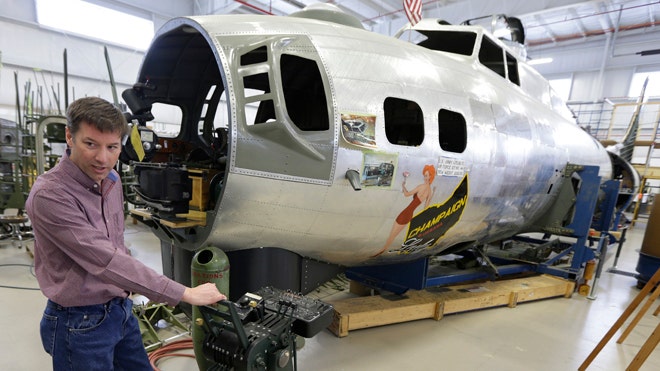
Feb. 20, 2014: Dave Shiffer displays a throttle quadrant that will be placed in the B-17 World War II-era bomber being built from salvaged and fabricated parts at the Champaign Aviation Museum in Urbana, Ohio. (AP)
URBANA, OHIO – Ohio museum volunteers are piecing together various plane parts to bring back to life a vintage aircraft from the World War II era. A piece was found under the porch of an elderly woman in the next town. Another part was bought from a bar owner who had it hanging in Colorado. Another piece was used as a prop in a TV show way back 1960. The tail section was from a wreck site in Alaska.
The dozens of volunteers are piecing together the parts like a jigsaw puzzle at a small Ohio museum. Once the project is complete, a new and airworthy model of one of the world’s most famous military planes, the World War II bomber B-17. The vintage aircraft made a mark in history as well as Hollywood movies like the “Twelve O’Clock High” and “Memphis Belle.”
The volunteers are working on a vintage plane based on a collection of 28,000 original Boeing Co. blueprints which the Smithsonian Institution provided generously. And they are making history. The plane has not been manufactured in almost 70 years. The volunteers do what they can to complete the model. They buy or barter the parts they need. What they can’t, the volunteers diligently make from scratch.
“Modesty aside — and I’ve been around airplanes as much as anybody here — I think we’re building a better airplane than Boeing did,” says volunteer Dick Bidlack. “But we’re not trying to build 15 of them a day in a wartime scenario. We’re taking years, so we have a little more freedom.” Dick Bidlack, 79 years old, was a Vietnam War fighter pilot. Since the start of the Champaign Aviation Museum project in 2005, the war veteran has been actively involved as a volunteer. The project is far from complete. But the shell of the plane that is displayed in the hangar signify that the volunteers are way on the right track in the re-building of the behemoth B-17.
The four engine bomber, B-17, measured 74 foot long and came to be known as the “Flying Fortress” because of its capability to withstand combat attacks and its lethal .50 caliber machine guns. Frank Drain, a volunteer, is the designer and painter in-charge of making the shell look authentic and vintage. The nose art is highlighted by an image of a “leggy 1940s pinup girl against an outline of Ohio and the plane’s Champaign Lady nickname.”
“If you had to pick an airplane that would attract the public attention, the B-17 is the one to pick,” said Drain. Drain, 61 years old, is the son of a radio operator of a B-17 during the Second World War. He is a teacher at a local vocational school on aviation. He also asks his students to help in the building of the Flying Fortress. The incomplete plane can be viewed by visitors when the museum is open.
The Fox News reports that there were more than 12,700 models of the aircraft build for the war effort. The planes were utilized in many missions including daylight precision bombing raids from small bases in England. Targets include crucial locations in occupied Europe. The missions between 1942 and 1945 were highly risky. Two out of three young men who were mostly in their 20s and who served on the planes were killed in combat.
The end of the war saw the decrease of the need of the B-17s. Most were left in plane grave yards at the mercy of the elements while others were utilized for other services. Today, there are around 40 models of the plane left, a few of which are airworthy. At the National Museum of the U.S. Air Force near Dayton, another famous B-17 is under restoration. The Memphis Belle is being brought back to life about 40 miles from the Champaign Lady. The Belle has made a mark in history and the military brass in 1943 for being the one of the first B-17s to survive 25 dangerous missions at a very critical period when many of the American bombers were downed.
The Museum spokesman, Rob Bardua, has disclosed that it will take years before the Belle is fully restored and ready for public display. But, visitors of the museum can take a glimpse of the restoration work that is currently being undertaken. The Urbana museum and the volunteers are working double time to complete the plane with the goal of making the Champaign Lady capable of flying again. The Bell and other B-17s at the National Museum will not be taken out for flight. “There was never a decision to make. When we started the project, it was to make it fly,” said Dave Shiffer. He first made a ride on a touring B-17 with his father and brother in 2005. The experience motivated him to pursue the B-17 project and creat the nonprofit museum.
The first five pieces were from five different sources. The other parts needed and cannot be found or restored had to be made from scratch. Randy Kemp, 56 years old, serves as the project manager who oversees the fabrication of new pieces. He also takes charge of around 100 volunteers who come and go. Some even come from as far as England to volunteer for the ambitious project.
Shiffer further said that the project will cost millions. Donations and fundraisers have contributed to the completion of the plane. The museum also plans to hold a benefit dinner in April at the museum. Amanda Wright Lane, a great grandniece of Orville and Wilbur Wright will be expected to appear in the dinner to give a talk.
